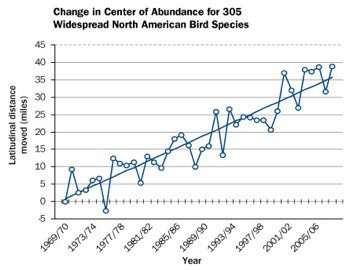 A report recently released by the Audubon Society indicates dozens of bird species have shifted northward over the past 40 years in an apparent response to changing climate.
A report recently released by the Audubon Society indicates dozens of bird species have shifted northward over the past 40 years in an apparent response to changing climate.
Scientists and volunteer bird-watchers have monitored and documented the wintering and breeding ranges for birds throughout North America. The results of the research shows that nearly 60% of 305 species that winter in North America have been “on the move” over the last four decades, shifting their ranges northward an average of 35 miles, and in some cases by hundreds of miles.
Audubon scientist Greg Butcher, coauthor of the report, says that the observed shifts dovetail with warming trends in winter temperatures,
We’re showing that global warming isn’t something that’s going to happen far away, say in the Arctic and Antarctic, and it’s not something that might happen in the future,” he says. “It’s something that’s already happened and has been occurring over the last 40 years.”
Much of the data collected is from “Citizen Science” efforts such as the Christmas Bird Count, a 109-year tradition where birders visit predetermined sites and record all the species they find within a 24-hour period. Recent counts have enlisted the help of more than 50,000 volunteers at 2,000 locations across North America.
 And it is these sorts of efforts that provide scientists the broad reach of data required to see and understand trends, says conservation biologist Stuart Butchart of BirdLife International:
And it is these sorts of efforts that provide scientists the broad reach of data required to see and understand trends, says conservation biologist Stuart Butchart of BirdLife International:
The strength of this study is that it’s looking at a broad range of species across a large geographic area,” he says. “It’s the overall pattern that’s important and should be raising alarm bells.”
Woodland birds, whose ranges shifted northward on average of 70 miles, are good indicators of trends, but it is the smaller ranging birds, with highly specialized habitats, that are most at risk. Such species will simply have no place to go.
We’re terribly worried about Hawaiian forest birds,” Say Butcher.
Warming temperatures allow mosquitoes to rise higher up mountain slopes, carrying avian malaria that has devastated lowland populations.
Changing climate can disrupt patterns of specie behavior and health in a variety of ways. According to information from the Audubon society website, these effects include :
- Geographic range
The ranges of many plants and animals are moving toward the poles and toward higher elevations. For example, the ranges of many British breeding birds were, on average, more than 11 miles farther north in the period from 1988-91 than they were in the period from 1968-72, according to comparisons derived from breeding bird atlases. (British butterflies are also being found farther north.) - Reproduction timing
Egg-laying, flowering, and spawning are occurring earlier for many species, in some cases disrupting delicate cycles that ensure that insects and other food are available for young animals. For example, Tree Swallows across North America have advanced egg-laying by as many as nine days from 1959 to 1991. - Migration timing and patterns
Spring migration is occurring earlier and fall migration later in many species. For example, 25 migratory bird species are arriving in Manitoba, Canada, earlier than they did 63 years ago; only two are arriving later. - Frequency and intensity of pest outbreaks
Global warming increases droughts in some areas; and spruce budworm outbreaks frequently follow droughts, perhaps because dry weather increases the stress on host trees or allows more spruce budworm eggs to be laid. Spruce budworms can be lethal to spruce trees, and spruce-fir forests are a very important habitat type in the northern hemisphere for a wide variety of plants and animals.
Sources and Further Reading:
ScienceNews
Audubon Society
Earthweek
Chart credit: Science News, D. Niven et.al., Audubon Society


